Determining Pre-Service Teachers’ Intention of Using Technology for Teaching English as a Second Language (ESL)
Abstract
:1. Introduction
2. Literature Review
3. Methodology
4. Findings
4.1. Measurement Models
4.2. The Structural Equation Modelling
- (1)
- Performance expectancy
- (2)
- Effort expectancy
- (3)
- Facilitating conditions
- (4)
- Technological, Pedagogical, and Content Knowledge
5. Discussion
6. Conclusions
Author Contributions
Funding
Institutional Review Board Statement
Informed Consent Statement
Data Availability Statement
Acknowledgments
Conflicts of Interest
References
- Abunowara, A.M. Using technology in EFL/ESL classroom. Int. J. Hum. Cult. Stud. IJHCS 2016, 1, 7–23. [Google Scholar]
- Dudeny, G.; Hocky, N. How to teach English with Technology; Pearson Longman: London, UK, 2007. [Google Scholar]
- Baek, Y.; Jung, J.; Kim, B. What makes teachers use technology in the classroom? Exploring the factors affecting facilitation of technology with a Korean sample. Comput. Educ. 2008, 50, 224–234. [Google Scholar] [CrossRef]
- Lubis, M.A.; Ariffin, S.R.; Muhamad, T.A.; Ibrahim, M.S.; Wekke, I.S. The integration of ICT in the teaching and learning processes: A study on smart school of Malaysia. In Proceedings of the 5th WSEAS/IASME International Conference on Education Technology, Canary Islands, Spain, 1–3 July 2009; pp. 189–197. [Google Scholar]
- Ahmadi, M.R. The Use of Technology in English Language Learning: A Literature Review. Int. J. Res. Engl. Educ. 2018, 3, 115–125. [Google Scholar] [CrossRef] [Green Version]
- Alsaleem, B.I.A. The Effect of “WhatsApp” Electronic Dialogue Journaling on Improving Writing Vocabulary Word Choice and Voice of EFL Undergraduate Saudi Students. Arab. World Engl. J. 2013, 4, 13. [Google Scholar]
- Nomass, B.B. The Impact of Using Technology in Teaching English as a Second Language. Engl. Lang. Lit. Stud. 2013, 3, 111. [Google Scholar]
- Milton, P. Trends in the Integration of ICT and Learning in K-12 Systems. 2003. Available online: http://www.cea-ace.ca/publication/trends-integration-ict-and-learning-k-12-systems (accessed on 30 June 2021).
- Yüksel, G.; Kavanoz, S. In search of pre-service EFL certificate teachers’ attitudes towards technology. Procedia Comput. Sci. 2011, 3, 666–671. [Google Scholar] [CrossRef] [Green Version]
- Hashim, Y. The Evolution of Instructional Technology in Malaysia. Int. J. Instr. Media 2010, 37, 11. [Google Scholar]
- Arifah. Study on the Use of Technology in ELT classroom: Teachers’ Perspective; BRAC University: Dhaka, Bangladesh, 2014. [Google Scholar]
- Lin, W.; Yang, S. Exploring students’ perceptions of integrating Wiki technology and peer feedback into English writing courses. Engl. Teach. Pract. Critique 2011, 10, 88–103. [Google Scholar]
- Sidupa, C.; Luke, J.; Kurniawan, C. The Role of ICT in Improving English Reading Ability: Case Study of 5th Semester University Students. In Proceedings of the 2nd International Conference on E-Society, E-Education and E-Technology-ICSET, Taipei, Taiwan, 13–15 August 2018; ACM Press: New York, NY, USA, 2018; pp. 42–45. [Google Scholar]
- Romaña Correa, Y. SkypeTM Conference Calls: A Way to Promote Speaking Skills in the Teaching and Learning of English. PROFILE Issues Teach. Prof. Dev. 2015, 17, 143–156. [Google Scholar] [CrossRef]
- Godzicki, L.; Godzicki, N.; Krofel, M.; Michaels, R. Increasing Motivation and Engagement in Elementary and Middle School Students through Technology-Supported Learning Environments; Saint Xavier University: Chicago, IL, USA, 2013; p. 144. [Google Scholar]
- Al-Ruz, J.A.; Khasawneh, S. Jordanian Pre-Service Teachers’ and Technology Integration: A Human Resource Development Approach. J. Educ. Technol. Soc. 2011, 14, 77–87. [Google Scholar]
- Velazquez-Torres, N. How well Are ESL Teachers Being Prepared to Integrate Technology in Their Classrooms? Tesl-EJ 2006, 9, n4. [Google Scholar]
- Wachira, P.; Keengwe, J. Technology Integration Barriers: Urban School Mathematics Teachers Perspectives. J. Sci. Educ. Technol. 2011, 20, 17–25. [Google Scholar] [CrossRef]
- Mishra, P.; Koehler, M.J. Technological Pedagogical Content Knowledge: A Framework for Teacher Knowledge. Teach. Coll. Rec. 2006, 108, 1017–1054. [Google Scholar] [CrossRef]
- Venkatesh, V.; Davis, G.B. User Acceptance of Information Technology: Toward a Unified View. MIS Q. 2003, 27, 425. [Google Scholar] [CrossRef] [Green Version]
- Betancourt-Odio, M.A.; Sartor-Harada, A.; Ulloa-Guerra, O.; Azevedo-Gomes, J. Self-perceptions on digital competences for m-learning and education sustainability: A study with teachers from different countries. Sustainability 2021, 13, 343. [Google Scholar] [CrossRef]
- Nasr, N. Teachers as Students. Electron. J. Res. Sci. Math. Educ. 2020, 24, 168–171. [Google Scholar]
- Leyton-Román, M.; González-Vélez, J.J.L.; Batista, M.; Jiménez-Castuera, R. Predictive Model for Amotivation and Discipline in Physical Education Students Based on Teaching–Learning Styles. Sustainability 2021, 13, 187. [Google Scholar] [CrossRef]
- Liu, S.-H. A Multivariate Model of Factors Influencing Technology Use by Pre-service Teachers during Practice Teaching. Educ. Technol. Soc. 2012, 15, 13. [Google Scholar]
- Batane, T.; Ngwako, A. Technology use by pre-service teachers during teaching practice: Are new teachers embracing technology right away in their first teaching experience? Australas. J. Educ. Technol. 2016, 33, 48–61. [Google Scholar] [CrossRef]
- Farjon, D.; Smits, A.; Voogt, J. Technology integration of pre-service teachers explained by attitudes and beliefs, competency, access, and experience. Comput. Educ. 2019, 130, 81–93. [Google Scholar] [CrossRef]
- Hoxha, M.; Tafani, V.; Kennetz, K. Challenges and Impact of Teaching English in Limited Access to Technology Environment. In Proceedings of the MIT LINC 2019 Conference, Cambridge, MA, USA, 18–20 June 2019; Volume 3, pp. 152–161. [Google Scholar]
- Singh, T.K.R.; Subramaniam, S.V. Pre-service Teachers’ ICT Literacy: A Case Study in a Malaysian Teachers’ Training Institution. Glob. J. Interdiscip. Soc. Sci. 2014, 3, 7. [Google Scholar]
- Burden, K.; Hopkins, P. Barriers and Challenges Facing Pre-Service Teachers use of Mobile Technologies for Teaching and Learning. Int. J. Mob. Blended Learn. 2016, 8, 1–20. [Google Scholar] [CrossRef] [Green Version]
- Kaba, B.; Touré, B. Understanding information and communication technology behavioral intention to use: Applying the UTAUT model to social networking site adoption by young people in a least developed country. J. Assoc. Inf. Sci. Technol. 2014, 65, 1662–1674. [Google Scholar] [CrossRef]
- Teo, T.; Noyes, J. Explaining the intention to use technology among pre-service teachers: A multi-group analysis of the Unified Theory of Acceptance and Use of Technology. Interact. Learn. Environ. 2014, 22, 51–66. [Google Scholar] [CrossRef]
- Holzmann, P.; Schwarz, E.J.; Audretsch, D.B. Understanding the determinants of novel technology adoption among teachers: The case of 3D printing. J. Technol. Transf. 2020, 45, 259–275. [Google Scholar] [CrossRef] [Green Version]
- Aypay, A.; Sever, M. Technology Acceptance in Education: A Study of Pre-service Teachers in Turkey. Turk. Online J. Educ. Technol. 2012, 11, 264–272. [Google Scholar]
- Baran, E.; Bilici, S.C.; Sari, A.A.; Tondeur, J. Investigating the impact of teacher education strategies on pre-service teachers’ TPACK. Br. J. Educ. Technol. 2019, 50, 357–370. [Google Scholar] [CrossRef] [Green Version]
- So, H.J.; Kim, B. Learning about problem-based learning: Student teachers integrating technology, pedagogy and content knowledge. Australas. J. Educ. Technol. 2009, 25, 101–116. [Google Scholar] [CrossRef] [Green Version]
- Mohd Razali, N.N.F. The Importance and Efforts in Using Technology to Improve Language Teaching and Learning and The Teacher’s Readiness for Integrating ICT in the Classroom in Malaysian Education. J. Educ. Soc. Sci. 2016, 5, 227–230. [Google Scholar]
- Johnson, A.M.; Jacovina, M.E.; Russell, D.G.; Soto, C.M. Challenges and Solutions when Using Technologies in the Classroom; Taylor and Francis: New York, NY, USA, 2016. [Google Scholar]
- Mahmood, F.; Halim, H.A.; Rajindra, S.; Ghani, M. Factors Affecting Teachers Utilization of Technology in Malaysian ESL Classrooms. Malays. Online J. Educ. Technol. 2014, 2, 15–23. [Google Scholar]
- Ursachi, G.; Horodnic, I.A.; Zait, A. How Reliable are Measurement Scales? External Factors with Indirect Influence on Reliability Estimators. Procedia Econ. Financ. 2015, 20, 679–686. [Google Scholar] [CrossRef] [Green Version]
- Dexter, S.L.; Anderson, R.E.; Becker, H.J. Teachers’ Views of Computers as Catalysts for Changes in Their Teaching Practice. J. Res. Comput. Educ. 1999, 31, 221–239. [Google Scholar] [CrossRef]
- Korkmaz, G.; Toraman, Ç. Are We Ready for the Post-COVID-19 Educational Practice? An Investigation into What Educators Think as to Online Learning. Int. J. Technol. Educ. Sci. 2020, 4, 293–309. [Google Scholar] [CrossRef]
- Naguib, G.H.; Alyamani, I.; Alnowaiser, A.M.; Hamed, M.T. Social Media Usage and Self-Perception among Dental Students at King Abdulaziz University, Saudi Arabia. J. Med Educ. 2018, 17, 11. [Google Scholar]
- Tondeur, J.; Scherer, R.; Siddiq, F.; Baran, E. Enhancing pre-service teachers’ technological pedagogical content knowledge (TPACK): A mixed-method study. Educ. Technol. Res. Dev. 2020, 68, 319–343. [Google Scholar] [CrossRef] [Green Version]
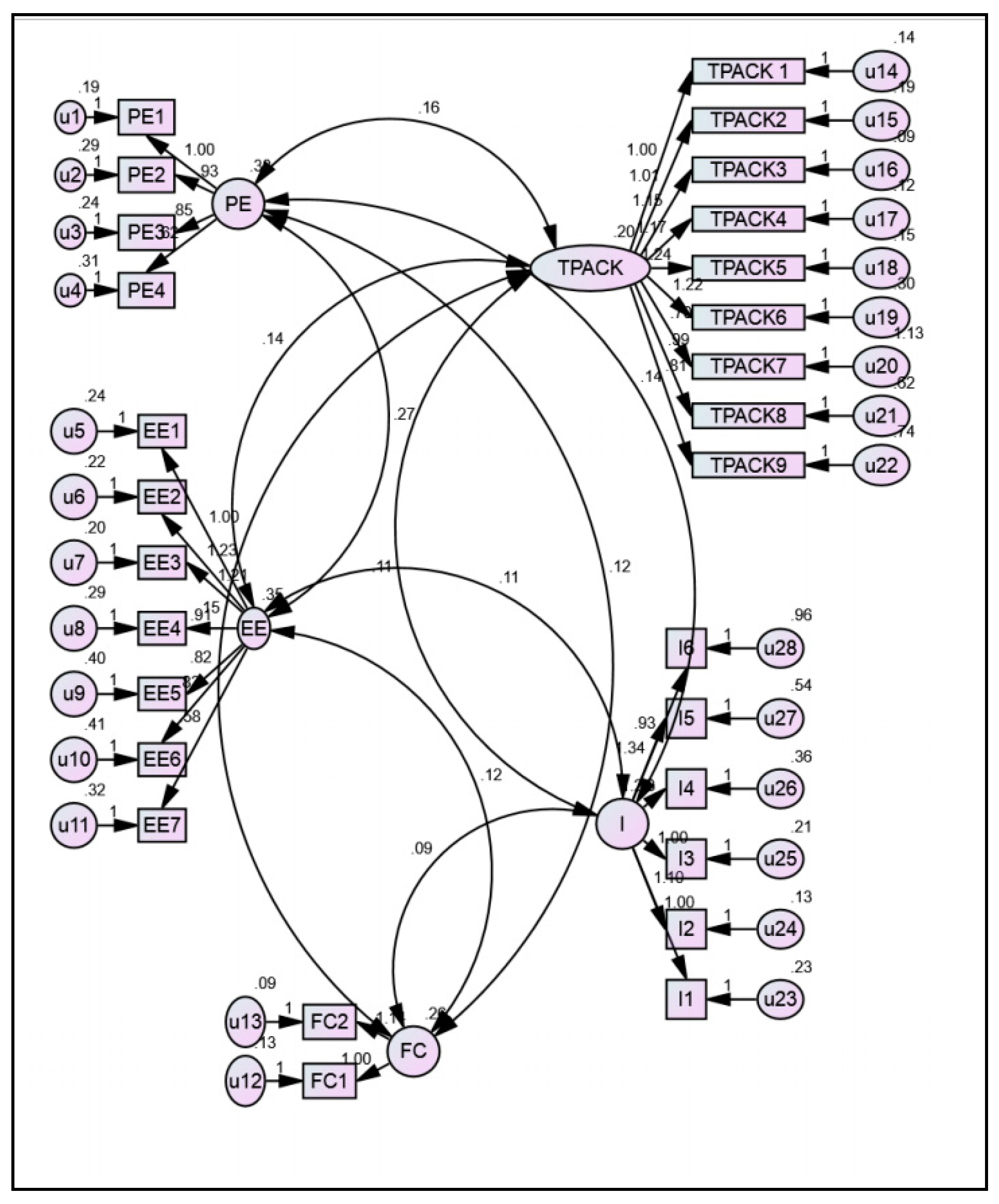
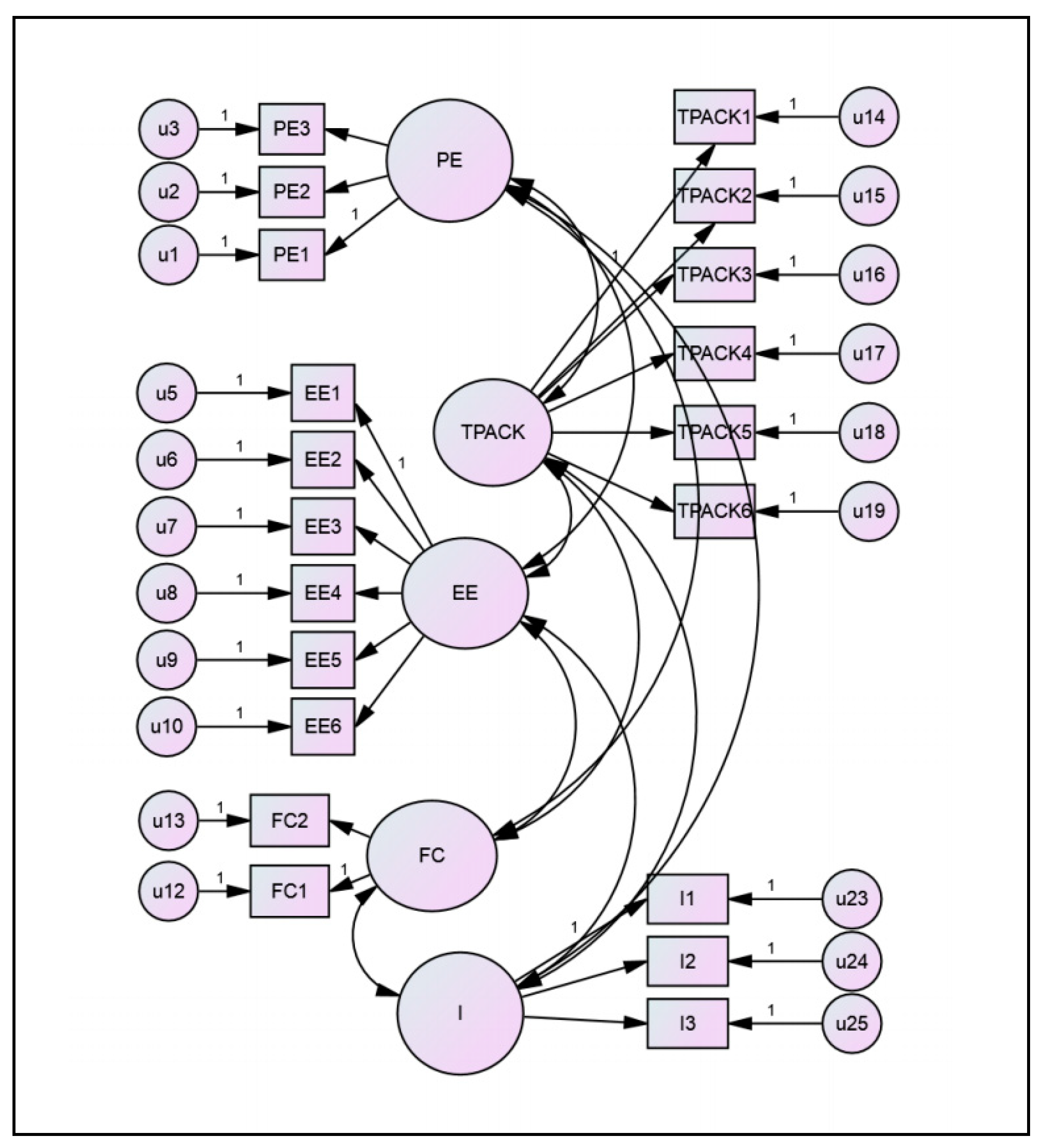
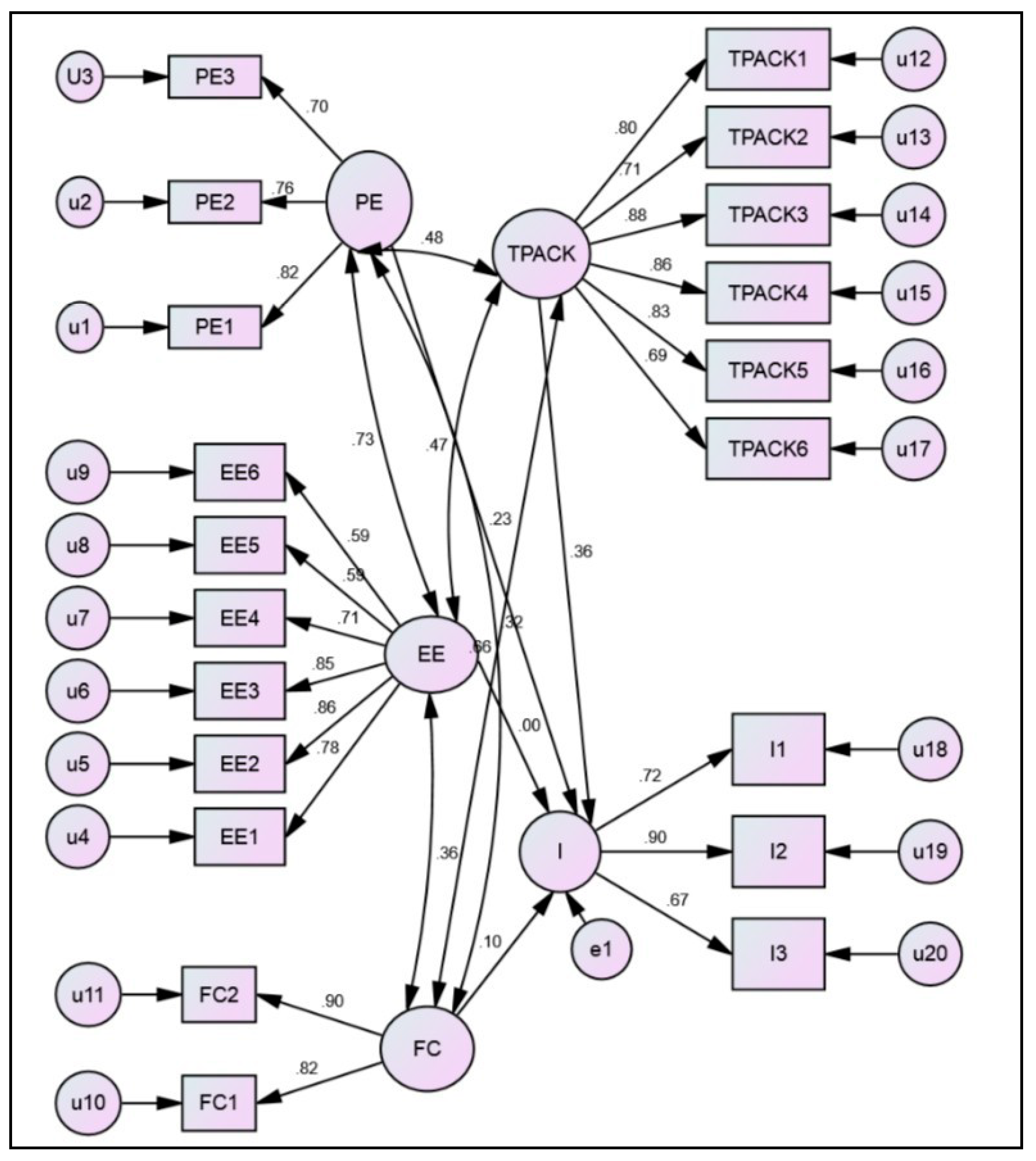
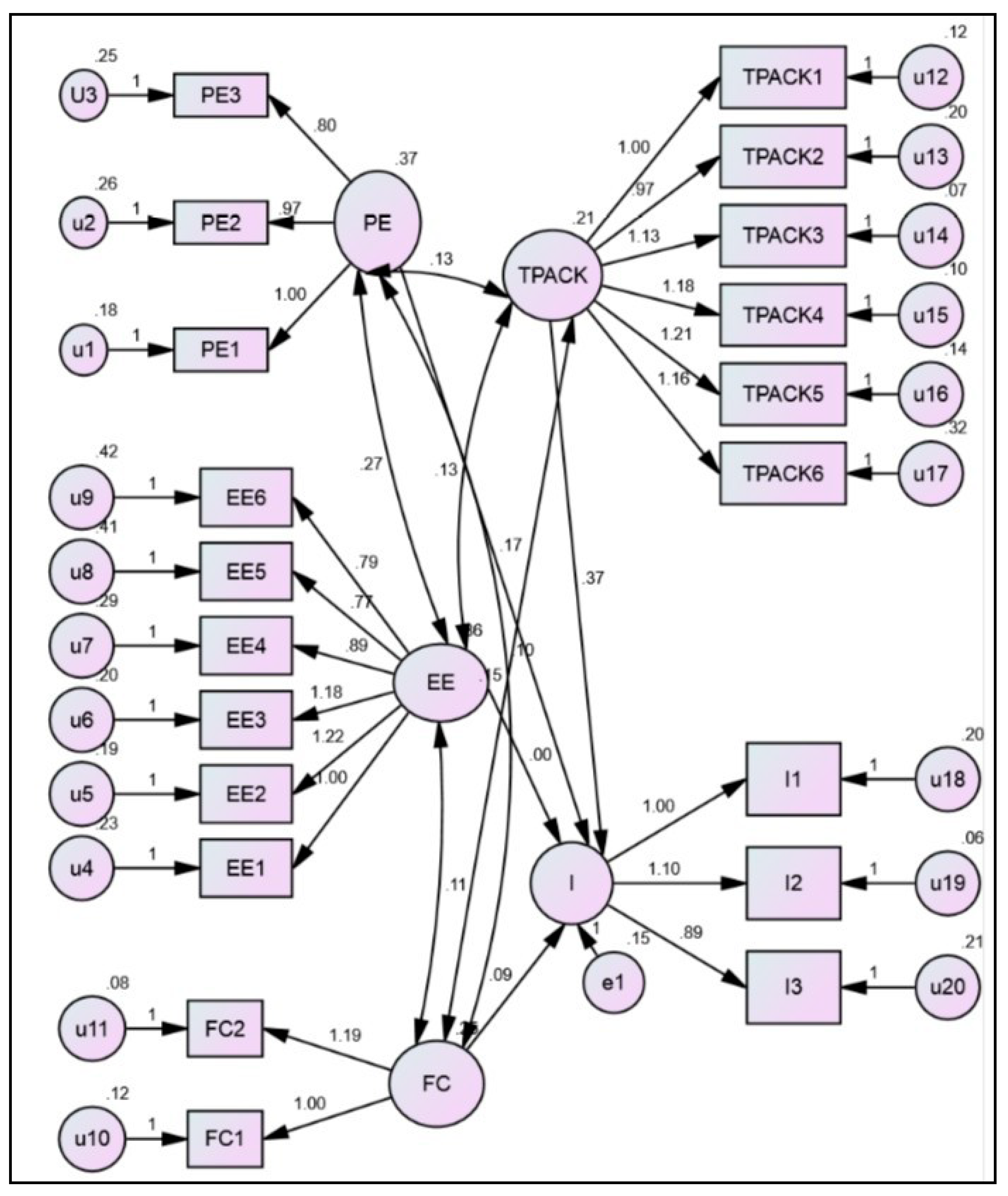

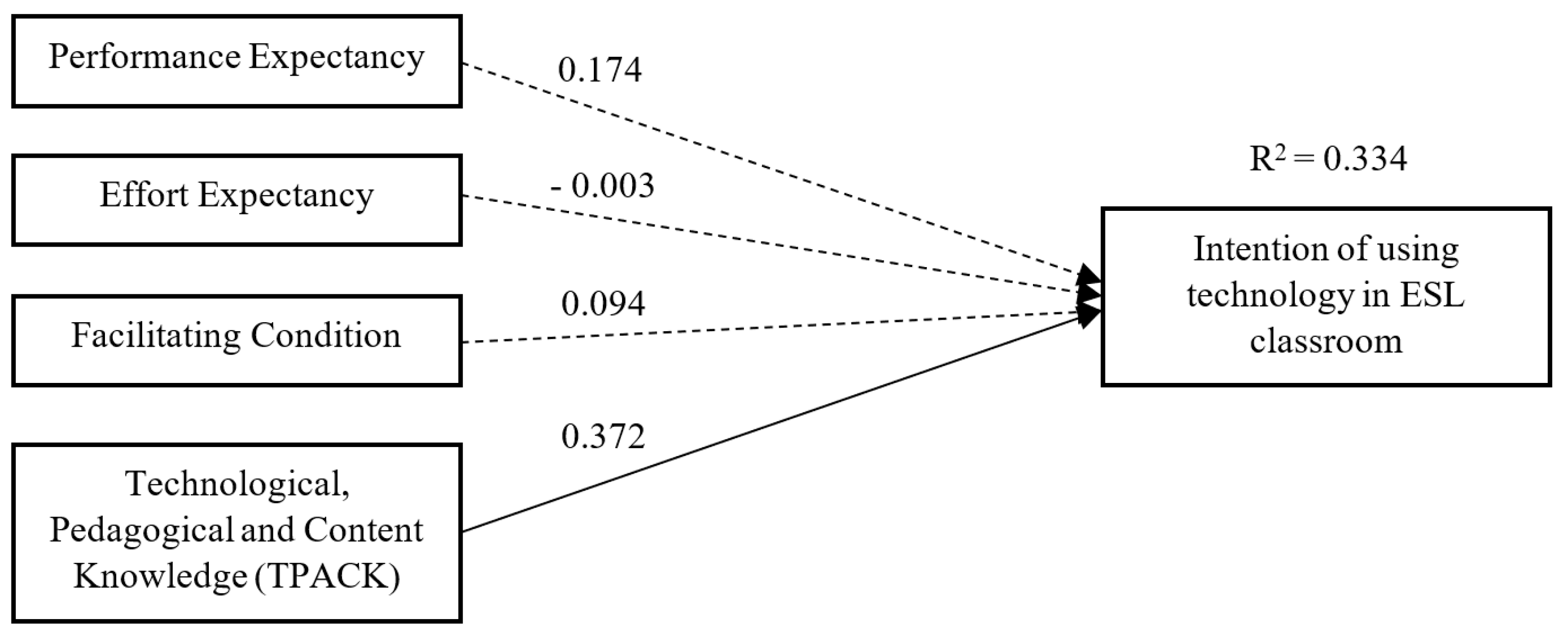
| Name of Index Category | Name of Index | Index Value | Level of Acceptance | Comments |
|---|---|---|---|---|
| Absolute fit | RMSEA | 0.091 | RMSEA 0.05 to 0.10 | The required level is achieved |
| Incremental fit | CFI | 0.813 | CFI > 0.90 | The required level is not achieved |
| Parsimonious fit | ChiSq/df | 2.960 | ChiSq/df < 3.0 | The required level is achieved |
| Name of Index Category | Name of Index | Index Value | Level of Acceptance | Comments |
|---|---|---|---|---|
| Absolute fit | RMSEA | 0.062 | RMSEA 0.05 to 0.10 | The required level is achieved |
| Incremental fit | CFI | 0.945 | CFI > 0.90 | The required level is achieved |
| Parsimonious fit | ChiSq/df | 1.915 | ChiSq/df < 3.0 | The required level is achieved |
| Name of Index Category | Name of Index | Index Value | Level of Acceptance | Comments |
|---|---|---|---|---|
| absolute fit | RMSEA | 0.066 | RMSEA 0.05 to 0.10 acceptable | The required level is achieved |
| Incremental fit | CFI | 0.938 | CFI > 0.90 | The required level is achieved |
| Parsimonious fit | ChiSq/df | 2.030 | ChiSq/df < 3.0 | The required level is achieved |
| Path | Standardised Beta Estimate |
|---|---|
| I <- PE | 0.226 |
| I <- EE | −0.003 |
| I <- FC | 0.101 |
| I <- TPACK | 0.363 |
| Path | Estimate | S.E. | C.R. | p | Result | ||
|---|---|---|---|---|---|---|---|
| I | <- | PE | 0.174 | 0.092 | 1.891 | 0.059 | Not significant |
| I | <- | EE | −0.003 | 0.086 | −0.029 | 0.976 | Not significant |
| I | <- | FC | 0.094 | 0.088 | 1.062 | 0.288 | Not significant |
| I | <- | TPACK | 0.372 | 0.108 | 3.458 | <0.01 | Significant at 0.10 |
Publisher’s Note: MDPI stays neutral with regard to jurisdictional claims in published maps and institutional affiliations. |
© 2021 by the authors. Licensee MDPI, Basel, Switzerland. This article is an open access article distributed under the terms and conditions of the Creative Commons Attribution (CC BY) license (https://creativecommons.org/licenses/by/4.0/).
Share and Cite
Lai Wah, L.; Hashim, H. Determining Pre-Service Teachers’ Intention of Using Technology for Teaching English as a Second Language (ESL). Sustainability 2021, 13, 7568. https://doi.org/10.3390/su13147568
Lai Wah L, Hashim H. Determining Pre-Service Teachers’ Intention of Using Technology for Teaching English as a Second Language (ESL). Sustainability. 2021; 13(14):7568. https://doi.org/10.3390/su13147568
Chicago/Turabian StyleLai Wah, Lim, and Harwati Hashim. 2021. "Determining Pre-Service Teachers’ Intention of Using Technology for Teaching English as a Second Language (ESL)" Sustainability 13, no. 14: 7568. https://doi.org/10.3390/su13147568
APA StyleLai Wah, L., & Hashim, H. (2021). Determining Pre-Service Teachers’ Intention of Using Technology for Teaching English as a Second Language (ESL). Sustainability, 13(14), 7568. https://doi.org/10.3390/su13147568






